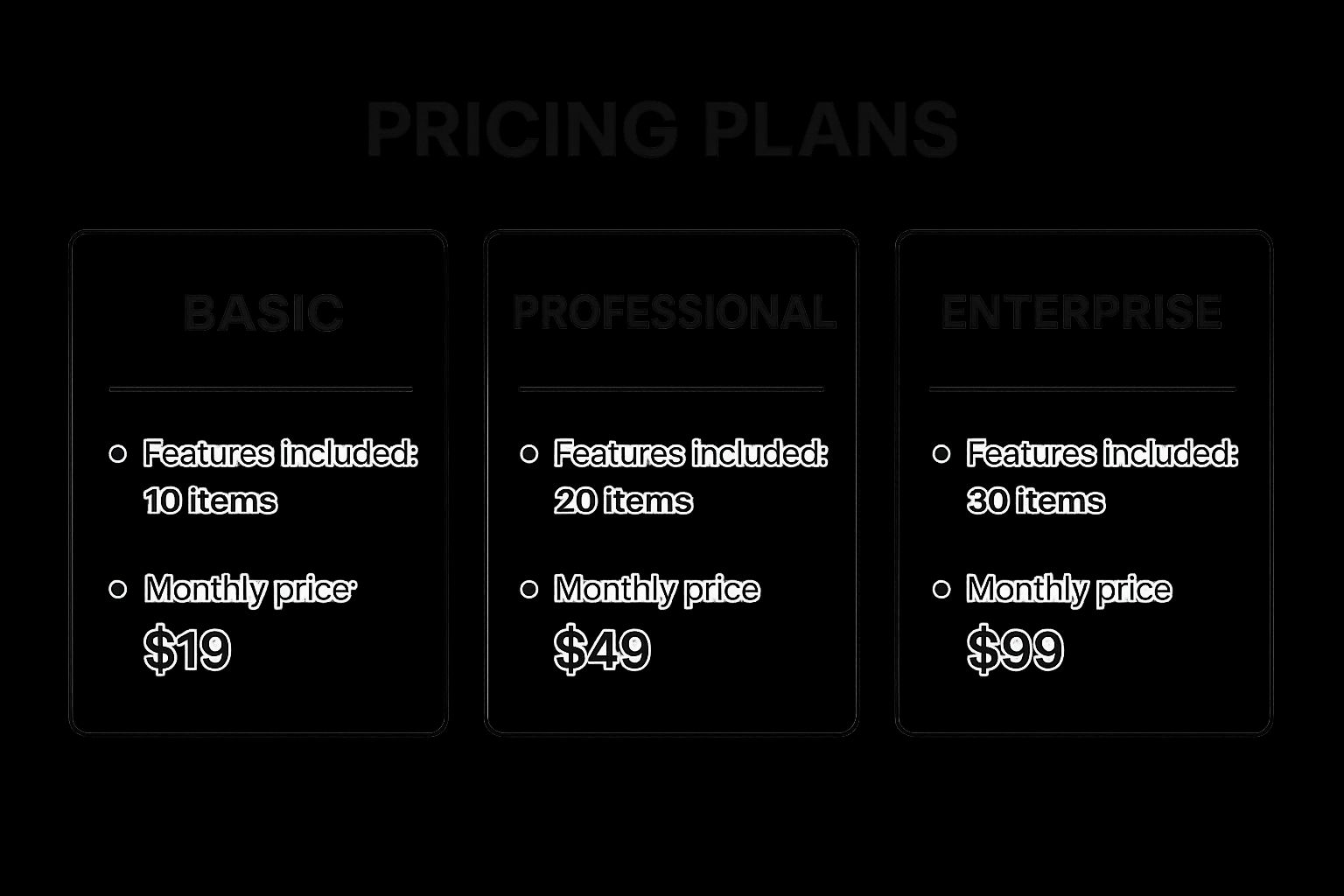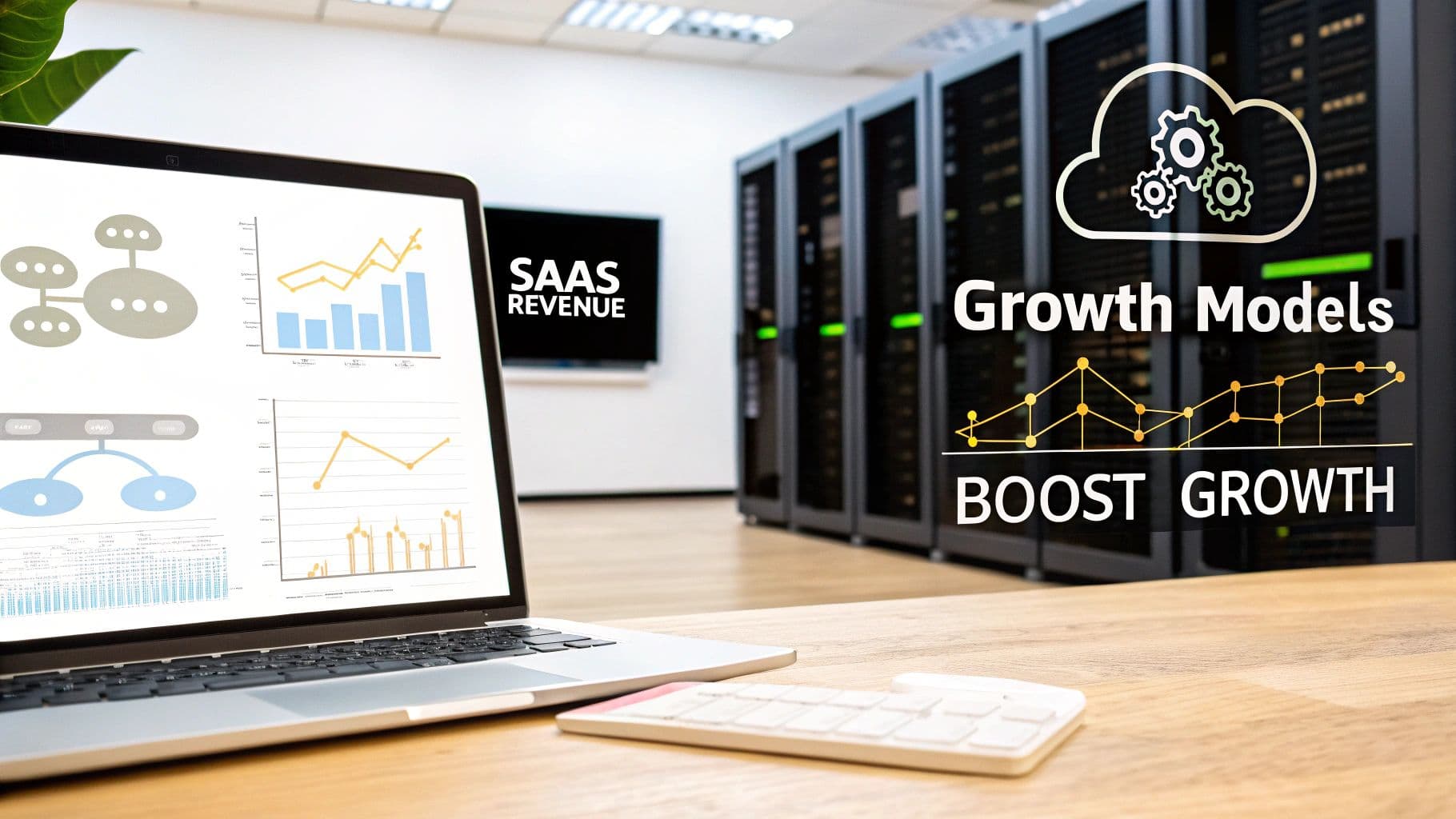saas revenue models
saas pricing
recurring revenue
subscription business
saas growth
Top SaaS Revenue Models to Boost Growth in 2025
Unlocking SaaS Success: Choosing the Right Revenue Model
Choosing the right SaaS revenue model is crucial for sustainable growth. This listicle explores six popular SaaS revenue models, outlining the strengths and weaknesses of each. Whether you're a startup founder, freelance agency, or an AI enthusiast prototyping a new SaaS product, understanding these models is key to maximizing your recurring revenue. Learn how subscription-based, usage-based, freemium, per-user, tiered, and hybrid SaaS revenue models can impact your business and discover which best suits your product and target audience.
1. Subscription-Based Model
The subscription-based model reigns supreme as the most prevalent of all SaaS revenue models. It's built on the foundation of recurring revenue, where customers pay a predetermined fee at regular intervals (monthly, quarterly, or annually) to access and utilize the software. This predictable revenue stream is a key driver of growth and stability for SaaS businesses, allowing for easier financial forecasting and strategic planning. The software itself is typically hosted in the cloud, enabling users to access it conveniently through web browsers or dedicated applications, anywhere with an internet connection. This accessibility and the recurring revenue structure foster long-term customer relationships, a vital component of success in the SaaS landscape.

This model's dominance in the SaaS world isn't accidental. Several key features contribute to its effectiveness: recurring revenue streams, tiered pricing options (e.g., basic, professional, enterprise) catering to diverse needs and budgets, regular billing cycles, automated renewals for seamless continuation of service, and centralized access via cloud infrastructure. Subscription-based models are the cornerstone of many SaaS businesses. Customers pay a recurring fee for access to the software. This model offers predictable revenue and encourages long-term customer relationships. For a comprehensive look at this model and its impact on ecommerce, check out this detailed guide: ecommerce subscription model from Sharpei's Ultimate Guide to Ecommerce Subscription Model: Expert Strategies for Predictable Growth.
The benefits are numerous. Predictable and stable revenue allows for better financial planning and investment. The emphasis on ongoing service leads to a higher customer lifetime value (LTV). While initial customer acquisition costs (CAC) might be higher, they decrease over time as customers remain subscribed. Easier cash flow forecasting empowers businesses to make informed decisions. Most importantly, this model builds long-term customer relationships, creating a loyal user base.
However, the subscription-based model isn't without its challenges. Customer churn, the rate at which customers cancel their subscriptions, can significantly impact revenue if not effectively managed. This necessitates continuous value delivery and product improvement to maintain subscriber satisfaction. The potential for longer sales cycles, particularly for higher-priced enterprise tiers, can also pose a hurdle.
Successful examples of this model abound in the SaaS market. Salesforce, a pioneer in cloud-based CRM, utilizes tiered subscriptions to cater to various business sizes. Microsoft 365 offers a range of personal and business subscription plans. Adobe Creative Cloud provides flexibility with monthly and annual subscription options. HubSpot’s marketing, sales, and service hubs also operate on a subscription basis. These examples illustrate the versatility and scalability of the subscription-based model across different industries and target audiences.
For those considering implementing this model, several tips can contribute to success. Optimizing pricing tiers based on perceived customer value is crucial. Offering annual discounts can incentivize longer commitments and improve cash flow. A strong focus on customer success is essential to reduce churn. Effective onboarding processes that quickly demonstrate the software’s value are key to early retention. Finally, diligently tracking and analyzing key subscription metrics like monthly recurring revenue (MRR), churn rate, CAC, and LTV is crucial for ongoing optimization and growth. The success of companies like Salesforce (Marc Benioff), Adobe's transition from perpetual licenses, Microsoft with Office 365, and NetSuite (Evan Goldberg and Larry Ellison) highlights the enduring power and potential of the subscription model in the SaaS world.
2. Usage-Based/Pay-As-You-Go Model
The Usage-Based/Pay-As-You-Go model is a SaaS revenue model where customers are charged based on their actual consumption of the software or specific features. Unlike traditional subscription models with fixed monthly or annual fees, the pay-as-you-go model aligns costs directly with value received. This makes it a particularly attractive option for customers with fluctuating needs, those wary of committing to long-term contracts, or businesses just starting out and unsure of their future usage. This model typically utilizes metered billing based on quantifiable metrics like API calls, storage used, processing time, bandwidth consumed, or the number of transactions processed.

This model's flexibility is a key differentiator among SaaS revenue models. Customers can scale their usage up or down as needed, only paying for what they consume. This scalability is often supported by granular tracking of usage metrics, providing both the customer and the SaaS provider with real-time insights into consumption patterns. Many providers employing this model also offer a free tier or a baseline allocation, allowing users to experiment with the software and experience its value before incurring significant costs. This freemium approach can be a powerful driver of initial adoption, particularly appealing to independent developers, hobbyists, and startups testing the waters.
Examples of Successful Implementation: Several prominent companies have successfully implemented this model, demonstrating its viability across different industries. Amazon Web Services (AWS) charges based on compute time, storage, and API calls. Twilio prices based on the number of messages or minutes used. Snowflake's data warehousing services are priced based on storage and compute usage. Stripe, a leading payment processing platform, charges fees per transaction. These examples illustrate how the usage-based model can effectively monetize various SaaS offerings, from infrastructure to communication tools and data warehousing.
Pros:
- Customers only pay for what they use: This eliminates the risk of paying for unused features or capacity.
- Lower barrier to entry: Free tiers and low initial costs make it easier for new users to try the software.
- Revenue scales with customer success: As customers grow and utilize the software more, revenue increases proportionally.
- Attractive for customers with variable usage patterns: Businesses with fluctuating needs can optimize their spending based on real-time demands.
- Can drive higher adoption through free or low-usage tiers: Freemium models can attract a wider user base.
Cons:
- Revenue may be less predictable: Fluctuating usage patterns can make forecasting revenue more challenging.
- Requires robust usage tracking infrastructure: Accurate and reliable usage tracking is crucial for billing.
- Billing can become complex: Metered billing for multiple services or features can be difficult to understand for customers.
- May limit revenue from low-usage customers: Users who consume minimal resources may generate minimal revenue.
- Potential for bill shock: Customers need to actively monitor their usage to avoid unexpected high bills.
Tips for Implementing a Usage-Based Model:
- Provide transparent usage dashboards: Give customers clear visibility into their usage patterns and associated costs.
- Set usage caps or alerts: Help customers avoid unexpected bills by setting limits or sending notifications.
- Consider hybrid models: Combine a base subscription with usage fees to balance predictability and flexibility.
- Price based on metrics that align with customer value: Ensure the chosen metrics reflect the value customers receive from the software.
- Design pricing that grows with customer success: Align pricing with customer growth and encourage increased usage.
When and Why to Use This Approach: This model is ideal for SaaS products where usage is variable and easily measurable. It's particularly suitable for infrastructure services, APIs, development tools, and other services where value is directly tied to consumption. For freelance agencies, startups, and AI enthusiasts working on prototypes, the pay-as-you-go structure provides a cost-effective entry point and allows for scaling as their projects develop.
This model's popularity is largely due to the influence of companies like AWS, Google Cloud Platform, Twilio, and Stripe, demonstrating its effectiveness and wide applicability in the SaaS landscape. This makes it a crucial model to understand for anyone involved in the SaaS industry.
3. Freemium Model
The Freemium Model is a popular SaaS revenue model that offers a compelling blend of accessibility and premium value. It works by providing a core version of the software product completely free of charge, while simultaneously offering paid tiers with enhanced features, expanded functionality, or priority support. This strategy leverages the power of free access to drive widespread product adoption and market penetration, aiming to convert a percentage of these free users into paying customers over time. This model is particularly effective for products with inherent network effects or viral growth potential, where a large user base contributes directly to the product's value. This deserves a place on the list of SaaS revenue models due to its widespread adoption and proven success in various niches.
The core components of a Freemium model include:
- Free core product: A functional, albeit limited, version of the software available to all users at no cost.
- Premium tiers: Various paid levels offering additional capabilities, such as increased storage, more users, advanced features, or dedicated support.
- Clear value differentiation: A transparent distinction between the free and paid tiers, showcasing the benefits of upgrading.
- Self-service upgrade paths: Easy-to-use mechanisms for free users to upgrade to a paid subscription at their convenience.
- Usage limitations: Often, the free tier incorporates limitations on usage, such as storage capacity, number of users, or access to specific features.
Pros:
- Lower acquisition costs: Attracting users with a free offering significantly reduces customer acquisition costs compared to purely paid models.
- Large user base: The free tier helps build a substantial user base, fostering network effects and increasing the product's overall value.
- Product feedback & data: Free users provide valuable product feedback and usage data, informing development and iteration.
- Organic marketing: A popular free offering can generate organic word-of-mouth marketing and positive online reviews.
- Value demonstration: Users can experience the product's value firsthand before committing to a purchase.
Cons:
- Low conversion rates: Converting free users to paying customers can be challenging, typically ranging from 1-5%.
- Supporting free users: Ongoing support for a large free user base can strain resources.
- Balancing free vs. paid: Finding the right balance between the free and paid offerings is crucial to avoid cannibalizing potential paying customers.
- High server/support costs: A popular free tier can lead to substantial server and support costs.
Examples:
- Slack: Offers limited message history and features in its free tier.
- Dropbox: Provides limited storage space for free accounts.
- Zoom: Limits free calls to 40 minutes.
- Mailchimp: Offers free email marketing for up to 2,000 contacts.
Tips for Implementing a Freemium Model:
- Design for upgrades: Design the free tier to demonstrate value while creating natural upgrade triggers by showcasing the benefits of the premium features.
- In-product prompts: Use subtle in-product prompts to highlight premium features and their value proposition.
- Target engaged users: Focus conversion efforts on active, engaged free users who are most likely to upgrade.
- Analyze usage patterns: Analyze usage data to identify conversion opportunities and tailor messaging accordingly.
- Time-limited trials: Offer time-limited trials of premium features to allow users to experience the full value proposition.
When considering SaaS revenue models, the Freemium approach is ideal for products with broad appeal and the potential for viral growth. If your product benefits from network effects or can gain traction through word-of-mouth, a Freemium model may be a strong fit. However, carefully consider the resources required to support a large free user base and the strategies necessary to drive conversions. Learn more about Freemium Model for further insights and inspiration. The Freemium model, popularized by companies like Dropbox (Drew Houston), Spotify (Daniel Ek), Slack (Stewart Butterfield), LinkedIn (Reid Hoffman), and Evernote (Phil Libin), has become a staple in the SaaS landscape, demonstrating its potential for sustainable growth and market dominance.
4. Per-User/Per-Seat Pricing Model
The per-user/per-seat pricing model is a common SaaS revenue model where customers are charged based on the number of individual users accessing the software. This straightforward approach directly ties revenue growth to the customer's team size and software adoption. It's a predictable and transparent model that makes budgeting and forecasting simple for customers, while allowing SaaS businesses to scale revenue effectively. This makes it a valuable SaaS revenue model to consider, particularly for applications where the value delivered increases with the number of users.

This model is particularly well-suited for collaborative tools, CRM systems, and project management software where the more team members engaged, the greater the overall benefit. Features often associated with per-user pricing include a fixed price per individual user account, different pricing tiers based on user roles (e.g., admin, power user, standard user), a centralized user management dashboard, and integration with feature-based tiers. This allows businesses to cater to different user needs and budgets while simplifying user administration.
Examples of successful implementations of this SaaS revenue model include Slack, which charges per active user with tiered feature sets; Atlassian, which prices Jira and Confluence per user; Salesforce CRM, which uses per-user pricing with feature tiers; and Monday.com, which charges based on the number of seats. These companies demonstrate the effectiveness of this model across different SaaS niches.
Pros:
- Transparent and predictable pricing: Customers understand exactly what they're paying for and can easily predict future costs based on their anticipated user count.
- Revenue growth aligned with customer adoption: As the customer's team grows and utilizes the software more, your revenue grows proportionally.
- Simplified budgeting and forecasting: Predictable costs make it easier for customers to manage their budgets.
- Easy to understand and communicate: The simplicity of the model makes it easy to explain to potential customers.
- Natural expansion revenue: As customers grow, they naturally add more users, leading to increased revenue.
Cons:
- Potential discouragement of full team adoption: High per-user costs can deter customers from adding all team members, potentially limiting the software's overall impact.
- Risk of account sharing: If not properly monitored and enforced, high per-user costs can incentivize unauthorized account sharing.
- Limited price differentiation based on value: It can be challenging to differentiate pricing based on the specific value received by different users.
- Potential lost revenue from high-value, low-user-count customers: Some customers might derive significant value from the software with a small team, leading to lower revenue compared to a larger, lower-value customer.
- Misalignment with value for some products: The model may not be suitable for products where value isn't directly tied to user count.
Tips for Implementing Per-User/Per-Seat Pricing:
- Consider volume discounts: Offer discounted rates for larger user counts to incentivize growth and attract larger clients.
- Differentiate user roles: Offer different pricing tiers based on user roles (e.g., admin, power user, standard user) to cater to varying needs and budgets.
- Monitor and control account sharing: Implement measures to detect and prevent unauthorized account sharing.
- Analyze usage patterns: Regularly analyze user engagement to ensure pricing aligns with the value received by different user segments.
- Incentivize user growth: Create incentives for adding users, such as bulk discounts or bundled features.
Learn more about Per-User/Per-Seat Pricing Model
This pricing model deserves a place in any discussion about SaaS revenue models due to its widespread adoption and proven effectiveness. Its simplicity and transparency make it attractive to both customers and businesses, particularly for software where value is tied to user count. However, understanding the potential drawbacks and implementing strategies to mitigate them is crucial for maximizing revenue and customer satisfaction. Pioneered by companies like Salesforce, Microsoft, Atlassian, Asana, and Slack, the per-user/per-seat model remains a popular and powerful option for SaaS businesses.
5. Tiered Feature-Based Pricing Model
The tiered feature-based pricing model is a popular SaaS revenue model that structures its offerings around distinct feature packages at increasing price points. Unlike per-user pricing, it emphasizes the value provided by specific functionalities rather than the number of users accessing the software. This allows businesses to cater to a wide range of customer needs and budgets, from startups seeking basic functionality to large enterprises requiring advanced features. Customers choose the tier that aligns with their requirements and have the flexibility to upgrade as their business grows. This makes it a particularly effective SaaS revenue model.

The infographic above summarizes the key aspects of the Tiered Feature-Based Pricing Model, highlighting the core components of tiered packages, feature differentiation, and the focus on value. It visually reinforces the concept of offering increasing functionality at higher price points, catering to diverse customer needs and budgets. This visual representation clarifies the structure and benefits of this model for SaaS businesses.
This approach to SaaS revenue models gives customers granular control over their spending by enabling them to pay only for the features they need. It also provides a clear path for upselling and expansion, as customers can easily upgrade to higher tiers to unlock additional functionality.
Here’s a quick reference for the key takeaways of this model:
- Focus: Feature differentiation, not user count.
- Structure: 3-5 tiers (e.g., Basic, Professional, Enterprise).
- Value: Increasing functionality at higher price points.
- Flexibility: Customers choose and upgrade as needed.
This inherent flexibility is one of the core strengths of the tiered feature-based pricing model. Let's dive into specific examples, benefits, and potential drawbacks.
Successful examples of this model are abundant in the SaaS landscape. HubSpot, a leading marketing automation platform, offers Starter, Professional, and Enterprise tiers across its product suite. Mailchimp, an email marketing service, segments its offerings into Essentials, Standard, and Premium tiers. Zoom, the popular video conferencing platform, provides Basic, Pro, Business, and Enterprise packages. These companies effectively demonstrate how tiered feature-based pricing can cater to diverse customer segments while driving revenue growth.
Pros:
- Appeals to various budgets: From bootstrapped startups to established enterprises.
- Clear upgrade paths: Facilitates organic growth and increased revenue.
- Value-based pricing: Customers pay for what they use, increasing perceived value.
- Higher ARPU potential: Enterprise tiers can significantly boost average revenue per user.
Cons:
- Complexity: Too many tiers or features can overwhelm customers.
- Feature distribution: Balancing features across tiers requires careful planning.
- Tier limitations: Customers may feel constrained by feature restrictions.
- Feature bloat: The temptation to add unnecessary features to justify higher tiers.
Tips for Implementation:
- Limit tiers: 3-5 options are generally recommended to avoid analysis paralysis.
- Strategic feature placement: Place high-value, low-cost features in higher tiers to incentivize upgrades.
- Persona-driven design: Tailor each tier to the specific needs of your target customer personas.
- Comparison tables: Use clear comparison tables to highlight the differences between tiers.
- Feature inclusion: Consider including all lower-tier features in higher tiers to provide a comprehensive package.
The tiered feature-based model deserves a prominent place in any discussion of SaaS revenue models because of its adaptability and effectiveness. By focusing on value and providing clear upgrade paths, it allows SaaS businesses to attract a broad customer base and maximize revenue potential. Whether you're an independent developer, a startup founder, or a product manager, understanding this model is crucial for building a successful SaaS business.
6. Hybrid/Mixed Revenue Model
The Hybrid/Mixed Revenue Model stands out among SaaS revenue models for its flexibility and ability to precisely align pricing with customer value. It's a powerful approach for SaaS businesses aiming to capture maximum revenue potential across diverse customer segments. This model essentially combines elements of multiple pricing strategies, offering a customized approach based on specific market needs and usage patterns. This makes it a particularly attractive option for companies offering a complex suite of services or targeting a wide range of user profiles.
Instead of relying on a single, rigid pricing structure, the Hybrid/Mixed Revenue Model often includes a base subscription fee coupled with variable components. This could involve usage-based charges, tiered upgrades for freemium users, per-user pricing with add-on modules, or even incorporating one-time purchases alongside recurring fees. Modular or add-on pricing structures are common features of this model. For example, a base subscription might provide access to core features, while additional modules unlock advanced functionalities or increased usage limits.
Several successful SaaS companies demonstrate the effectiveness of this model. Amazon Web Services (AWS), a pioneer in hybrid pricing, combines subscription reserved instances with pay-as-you-go usage, allowing customers to balance cost predictability with flexibility. Zendesk uses per-agent pricing complemented by add-on modules for enhanced features. New Relic similarly offers subscription tiers combined with data usage pricing, and GitHub blends per-user pricing with repository-based pricing. These examples showcase the versatility of the Hybrid/Mixed Revenue Model across various SaaS niches.
Pros:
- More precise alignment with actual customer value: Customers only pay for what they use and value, leading to higher customer satisfaction and reduced churn.
- Flexibility to address diverse customer segments: Different pricing combinations can cater to the specific needs and budgets of various user groups.
- Potential for higher revenue per customer: By capturing value from multiple avenues, businesses can maximize their revenue potential.
- Can capture value from different usage patterns: Variable components address fluctuating usage needs and prevent customers from feeling overcharged or under-served.
- Allows for creative pricing strategies: The hybrid approach fosters innovation in pricing and allows businesses to experiment with different value propositions.
Cons:
- More complex to communicate and explain to customers: The multifaceted nature of hybrid pricing requires clear and concise communication to avoid customer confusion.
- Challenging to implement technically: Sophisticated billing systems are necessary to support the intricacies of hybrid models.
- May complicate financial forecasting and reporting: Predicting revenue can be more complex due to the variable components.
- Potentially confusing billing for customers: Clear and detailed invoices are crucial to prevent billing disputes and maintain transparency.
- Requires sophisticated pricing strategy: Careful planning and analysis are needed to determine the optimal combination of pricing elements.
When and Why to Use This Approach:
The Hybrid/Mixed Revenue Model is ideal for SaaS businesses that:
- Offer a diverse range of features and functionalities.
- Target customers with varying usage patterns and needs.
- Seek to maximize revenue potential and customer lifetime value.
- Are prepared to invest in robust billing and reporting systems.
Tips for Implementing a Hybrid/Mixed Revenue Model:
- Prioritize simplicity in communication: Clearly explain the different pricing components and how they work together.
- Provide clear billing summaries and forecasts to customers: Transparency in billing is paramount to build trust and avoid confusion.
- Test different hybrid combinations with market segments: A/B testing can help determine the most effective pricing strategy for each customer group.
- Consider customer acquisition and retention impacts: Analyze how the pricing model affects both attracting new customers and retaining existing ones.
- Develop flexible billing systems that support hybrid approaches: Invest in scalable billing infrastructure that can handle the complexity of hybrid pricing.
Learn more about Hybrid/Mixed Revenue Model This resource offers valuable insights into B2B SaaS strategies, including further details on hybrid revenue models and their applications.
By carefully considering the pros and cons and implementing these tips, SaaS businesses can leverage the Hybrid/Mixed Revenue Model to achieve sustainable growth and maximize their revenue potential. This model offers a powerful framework for capturing value while catering to the diverse needs of today's SaaS customers, making it a deserving inclusion in any discussion of SaaS revenue models.
SaaS Revenue Models Comparison
| Revenue Model | Implementation Complexity 🔄 | Resource Requirements 💡 | Expected Outcomes 📊 | Ideal Use Cases 💡 | Key Advantages ⭐ |
|---|---|---|---|---|---|
| Subscription-Based Model | Medium 🔄 | Moderate (billing systems, support) 💡 | Predictable, stable revenue 📊 | Products requiring long-term customer relationships, B2B SaaS | Recurring revenue, higher LTV, stable cash flow ⭐ |
| Usage-Based/Pay-As-You-Go Model | High 🔄 | High (usage tracking, metering) 💡 | Revenue scales with usage but less predictable 📊 | Variable usage products, cloud services, APIs | Customers pay only for usage, scalability ⭐ |
| Freemium Model | Medium 🔄 | Moderate (free user support, infrastructure) 💡 | Large user base, low conversion rate 📊 | Products with network effects, viral growth potential | Low acquisition cost, organic marketing ⭐ |
| Per-User/Per-Seat Pricing Model | Low-Medium 🔄 | Low-Moderate (user management system) 💡 | Predictable, scales with team size 📊 | Team collaboration, CRM, project management tools | Transparent pricing, easy to budget ⭐ |
| Tiered Feature-Based Pricing Model | Medium 🔄 | Moderate (feature development per tier) 💡 | Clear upgrade paths, segmented revenue 📊 | Products with varied customer needs, functionality tiers | Appeals to multiple segments, value-based pricing ⭐ |
| Hybrid/Mixed Revenue Model | High 🔄 | High (complex billing and tracking) 💡 | Flexible, potentially higher revenue but complex 📊 | Diverse customer segments, flexible product offerings | Precise value alignment, maximizes revenue potential ⭐ |
Building Your SaaS Empire: Implementing the Right Revenue Model
Choosing the optimal SaaS revenue model is crucial for sustainable growth. We've explored several key models, from the traditional subscription and per-user pricing to the increasingly popular usage-based and freemium models, as well as the flexibility of tiered feature-based and hybrid approaches. Remember, the best SaaS revenue models are those that align with your product’s value proposition, target audience, and long-term business goals. Mastering these concepts empowers you to not only attract and retain customers but also to scale your business effectively and maximize profitability. By understanding the nuances of each model and carefully considering factors like customer acquisition cost, lifetime value, and market competition, you can lay the foundation for a thriving SaaS business.
Implementing the right SaaS revenue model from the outset is paramount, but iterating and adapting as your product and market evolve is equally important. Whether you're launching a new SaaS product with a subscription model or exploring a hybrid approach, understanding your options is key to building a successful SaaS empire. Ready to streamline your SaaS development and accelerate your time to market, regardless of your chosen revenue model? Explore how AnotherWrapper can empower you to build and launch faster, giving you a competitive edge in the dynamic SaaS landscape.
Fekri




